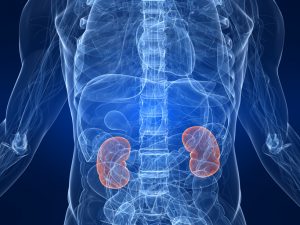
High blood pressure results from renal artery stenosis, because low blood flow to the kidneys leads the body to believe that blood pressure is low. To compensate, the body releases hormones to bring the blood pressure up, causing hypertension. Over time, this can contribute to kidney failure. This type of hypertension is known as renovascular hypertension.
Renal artery stenosis causes, risk factors, and complications
There are two main causes of renal artery stenosis: atherosclerosis of the renal arteries and fibromuscular dysplasia. Atherosclerosis of the renal arteries is when there is a buildup of fat or cholesterol along the artery walls, causing them to narrow. This plaque buildup causes the arteries to stiffen and harden, largely reducing the blood flow.
Fibromuscular dysplasia is when the muscle in the artery grows abnormally, resulting in narrow sections and wider sections. In some sections, the artery can narrow so much that adequate blood flow doesn’t reach the kidneys, causing renal damage. The cause of fibromuscular dysplasia is unknown, but it is seen more often in women than in men.
Risk factors for renal artery stenosis include having high cholesterol, having high blood pressure, being older in age, smoking, being overweight, having a family history of heart disease, not getting enough exercise, and having diabetes.
Complications that can arise from renal artery stenosis include renovascular hypertension as mentioned above, kidney failure, fluid retention in the legs, and shortness of breath.
Renal artery stenosis symptoms
Renal artery stenosis can be symptomless, and in many cases symptoms will not become present until the condition has advanced to more serious stages. It may be uncovered accidently during a routine check-up with your doctor.
Symptoms of renal artery stenosis include:
- High blood pressure that occurs suddenly
- High blood pressure that begins prior to the age of 30 or after the age of 55
- Difficult to treat blood pressure
- A whooshing sound of blood flow which your doctor hears through a stethoscope
- Elevated protein levels in the urine
- Worsening kidney function
- Fluid overload and swelling of the body tissues
- Treatment-resistant heart failure
Renal artery stenosis diagnosis
To diagnose renal artery stenosis, your doctor will need to perform a complete physical examination to find the cause of your symptoms. They will run blood and urine tests to assess kidney function and check the levels of hormones responsible for regulating blood pressure.
Imaging tests are also used to diagnose renal artery stenosis, which include Doppler ultrasound, CT scans, MRA scans, and renal arteriography, which is a special X-ray to look at blood flow and blockages of the renal arteries.
Renal artery stenosis treatment
Lifestyle changes and medical intervention can be used to treat renal artery stenosis. Lifestyle changes include:
- Maintaining a healthy weight or losing weight if you are overweight
- Eating healthy foods
- Limiting your salt intake
- Increasing exercise
- Reducing your stress levels
- Reducing your intake of alcohol and caffeine, or eliminating it completely
- Not smoking
Medications to treat renal artery stenosis include angiotensin-converting enzyme (ACE) inhibitors and angiotensin II receptor blockers (ARBs), diuretics, beta-blockers and alpha-beta blockers, and calcium channel blockers, which work to lower and control blood pressure.
Procedures to treat renal artery stenosis aim to restore blood flow to the kidneys. These may include renal angioplasty and stenting, renal artery bypass surgery, and renal endarterectomy.
Depending on the severity of your condition, your doctor will advise which mode of treatment is best for you.
Related: Renal colic: Symptoms, causes, and prevention tips